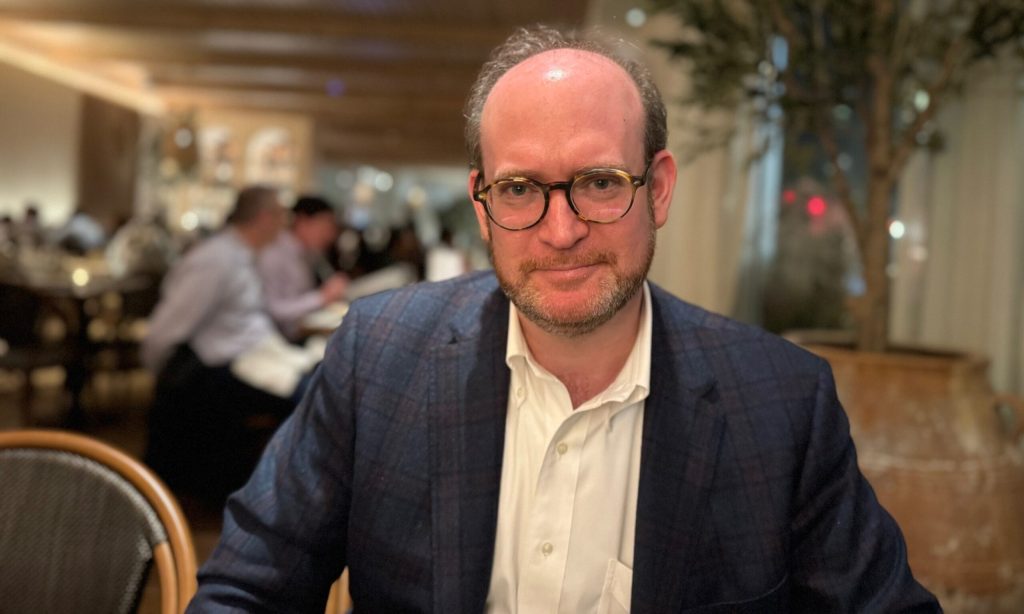
Written by Katrin Surkan
“I’ve always known I wanted to be a professor of linguistics, ever since I was five years old,” Dr. Katz insisted as we walked around campus in beautiful spring weather. Dr. Joshua Katz was invited to teach a one-week intensive course on linguistics in spring 2024, and his class inspired me, as one of the students, to share my joy. His passion and lifelong dedication to linguistics and teaching shows. He knows what linguistic family Tocharian belongs to (a pair of languages of the Silk Road, only attested in old documents and long dead) and how to reconstruct the Proto-Polynesian word for “to thatch a roof” from modern Hawaiian, Fijian, Maori, and Samoan words. He can explain the evolution of the English language, including how our word “hound” and German “Hund,” meaning “dog,” are related to “canis” in Latin. He has incredible knowledge of language, its fluidity and evolution, and examples to make it concrete, yet Dr. Katz somehow gifted his students with the feeling of discovering all these beautiful facets for ourselves.
Grateful for the purpose and flexibility behind his current job, Dr. Katz works as senior fellow at the American Enterprise Institute (AEI) in Washington, D.C. He focuses “on higher education, language and culture, the classical tradition, and the humanities broadly defined,” as listed in his bio for AEI. All four subjects came together in a Classics Department-sponsored class to engage a ready, eccentric audience in the linguistic community at Hillsdale College. Though one of the largest classes the College provides, at 42 registered students, it felt more like a seminar than a lecture.
In the first class, Dr. Katz asked us students to introduce ourselves and list a language of our choosing; “any language,” he said. It took eight students to list “English” among languages like “Azerbaijani,” “Pontic,” “Vulcan,” and “Bantu.” Nonetheless, he guided the class to draw connections between Hebrew and Yiddish because of their relationship, Spanish and Basque because of their shared place, Vulcan and Alethi because of their constructed origins, and American Sign Language and Chinese because of the representational origin of many of their signs. The joy of education shows itself in a teacher’s ability to run with students’ mostly-off-topic comments, keep the class’s attention while drawing it back to the lesson, and imbue a sense of wonder in exploring the topic at hand. I was grateful to be reminded of my love of learning through Dr. Katz’s master teaching.
All Dr. Katz’s teaching skills came together in his ability to transform the everyday English language into a miraculous discovery. He traced back the English language through Proto-Germanic all the way to Proto-Indo-European, showing us how the sounds shifted along the way. Armed with these rules, we could transform a modern English word into another Indo-European language. After connecting so much of English to other languages, its unique oddities stood out even more. For example, English’s unique “r” sound stems from the “wr” combination that remains in words like “wring,” “wrong,” and “wrestle.” Though the “w,” a sound made with lip-rounding, has fallen from the pronunciation, it influenced the following “r”—and this newly rounded “r” has replaced all “r’s,” even those, like “ring,” that never had a preceding ‘w.” By unveiling the story behind words and sounds we used thoughtlessly in day-to-day language, Dr. Katz re-introduced us to the wonder of discovering English, like little children first playing with sounds to communicate.
Dr. Katz did just that, bringing energy and creativity into the late, long classes. He riffed off his nine-month-old daughter’s fussing to explain the difference between language structure perception in mind and use in speech. Little Calliope might begin to understand and respond to English, forming connections between concepts and English words and syntax subconsciously, even if she may not be able to communicate in the same language. He admitted the limits of his knowledge and humbly shared the vast content of it with anyone who asked. Unafraid to redirect the class, he guided rabbit trails of conversation to beautiful scenic views of language and back toward the main path of the course. Dr. Katz not only led the class through a wonder-filled week of learning, but also nurtured a love for linguistics among his students that we have continued to explore even after the weeklong course ended.
Hillsdale College draws the kind of students who create group chats after classes are done just to continue discussing the semantics of language. It welcomes the kinds of professors who dedicate their week to teaching enraptured students from all majors the evolution of the word “you.” And everywhere, it brings together joyful minds to learn more about the goodness, beauty, and truth of the world we inhabit.
Katrin Surkan, ’25, has roots on the east coast but can almost always be found traveling. When not writing, reading, or chatting with someone new, she’s likely looking for a dog to pet or singing at the top of her lungs between classes with a cappuccino in hand.
Published in May 2024
